Hello everyone!
Today I bring something delicious! If you’ve been following me on Instagram or Facebook, you already know I’ve been experimenting with lievito madre, and I even made panettone with it! 🙂

Lievito madre is the stiff sourdough starter used by Italian bakers to make panettones the artisanal way. This method requires a lot of flour and a lot of refreshments during the first 15 days, and while the first-week discards are not suitable for baking, the rest are. Especially the 3 discards from the 3 preparatory refreshments before making panettone.
If you want to learn how to make your own lievito madre check this post!
Every time I did a refreshment, I had 150-200 g of lievito madre that I threw away. On day 9 or 10 of the process, I made a loaf of bread and it turned out great, so the next day I used the discards to make challah and it turned out great too. The taste was amazing, and it just had a pleasant hint of sourness.
Sourness in enriched dough has been my pet peeve and the reason I usually use commercial yeast. I can’t stand a bread that’s supposed to be sweet and yet the only thing you taste is a strong acidic flavor. I like that on country loaves, but not on brioche or a croissant.
That’s the whole point of working with lievito madre (either soaked in water or tied up in a cloth). In the soaked in water method, part of the acid is released in the water. Don’t forget that this sourdough starter is used in panettone, and real Italian panettones are not acidic at all. You shouldn’t be able to tell that the panettone was made with sourdough.
Baking with lievito madre
Working with lievito madre is addictive, seriously! I don’t even care how much time I’ve invested in creating it, or how much flour I’ve used. I can tell how differently the dough behaves, the different aromas compared to my regular sourdough starter, etc.
Based on the amazing flavor and incredible texture of the challah I baked, I decided to experiment a bit more and make cinnamon rolls. Because I have yet to find a recipe that doesn’t turn out into super dry rolls.
This recipe doesn’t have frosting because I wanted to taste the bread, the aromas from the lievito madre and how they combined with the ingredients on the recipe.
I did tweak the recipe a bit and I used orange syrup and orange blossom water in the dough, the filling has ground walnuts, ground cinnamon, and orange zest, and the icing has orange juice instead of milk or water.
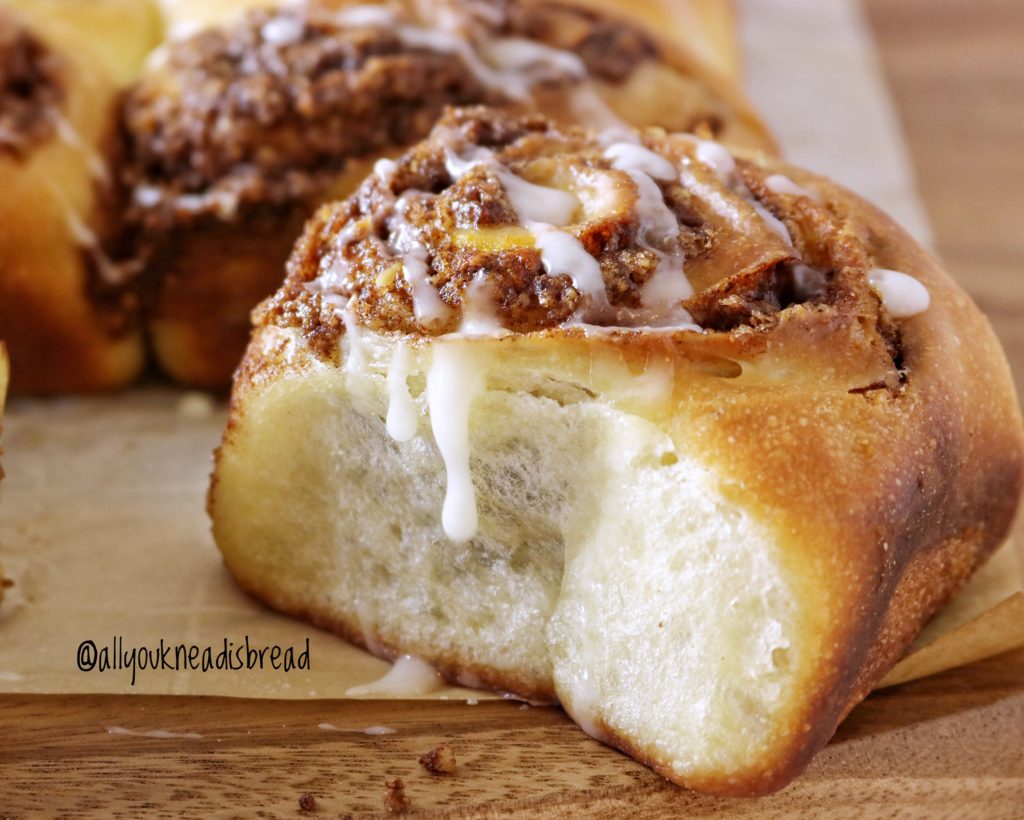
The result was amazing, the lievito madre helped to balance the aromas of the dough and significantly improved the texture of the rolls, they were soft and chewy and delicious! Even though I used lievito madre that had never been “purified” before (by doing a bagnetto, a technique to reduce the acidity of the dough when making panettone with lievito madre), and the dough fermented for 8h at room temperature and another 8 in the fridge, the rolls tuned out delicious with a pleasant hint of sourness, you could tell they were made with sourdough but the flavor was great.
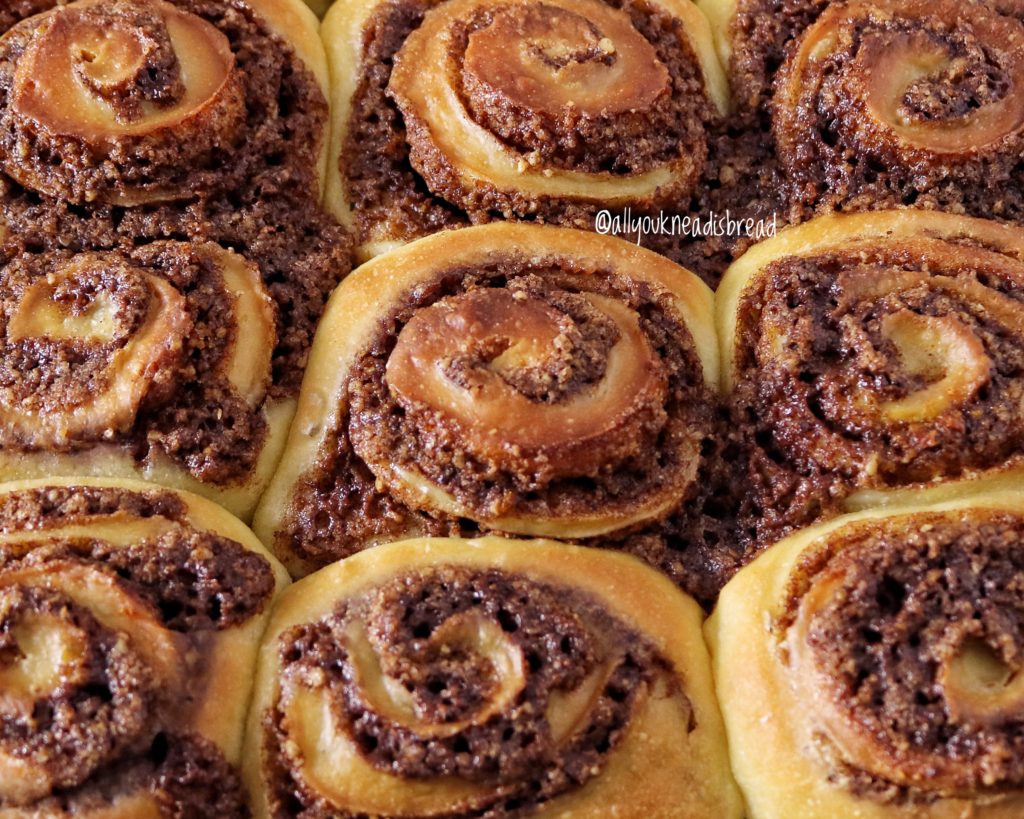
I think the texture of the dough was also different, it was more forgiving, and I could develop the gluten with a much gentle kneading that using levain or commercial yeast.
Let’s get into the recipe!
After draining, squeezing and using part of the lievito madre to do the refreshment, take the discards, weight how much you need and cut it into small pieces (half an inch or so) so they can be absorbed into the dough faster.
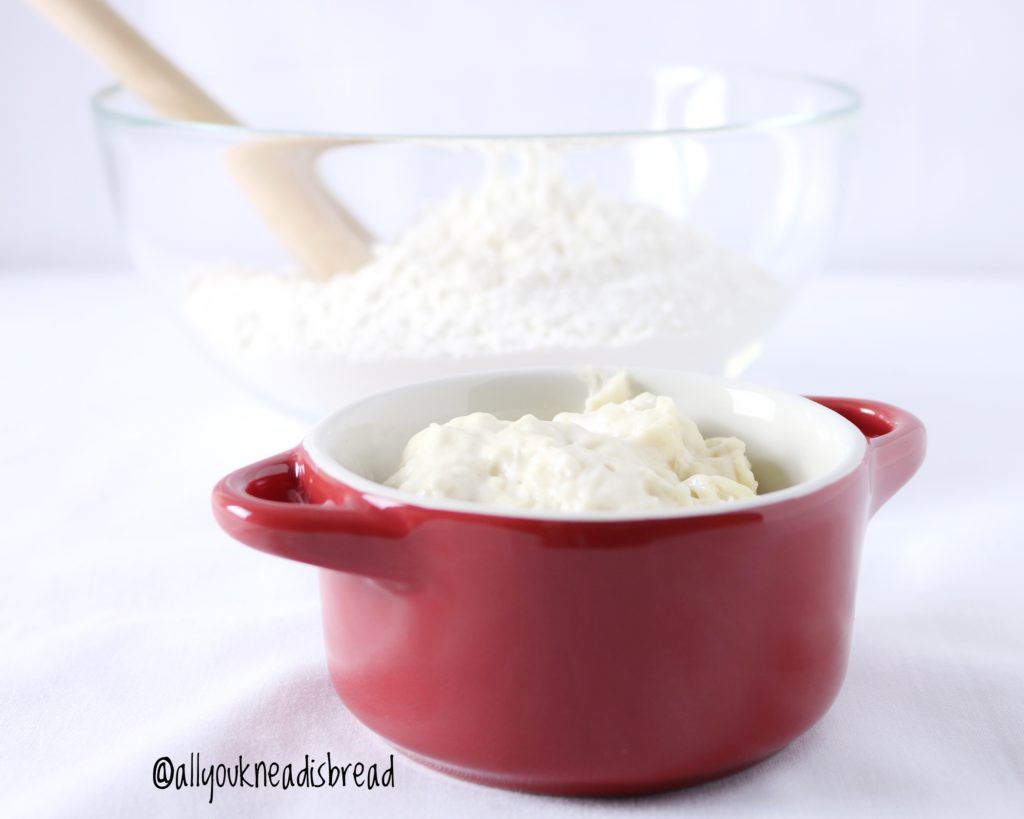
In your stand mixer bowl, add the wet ingredients and combine very well, then add the flour and the lievito madre in pieces.
Knead until the dough gets some elasticity and then add the softened butter. continue kneading until you have a perfect gluten development. You will have to stop a few times and let the dough rest for some minutes. You can check this post to learn how to knead enriched dough.
Once the dough is ready, shape it into a ball and place it in a lightly oiled container. Cover it and let it ferment at room temperature until it doubles in size. Mine took about 8h (the milk and the egg were cold). Place the dough in the fridge and let it ferment another 8h (I left it in the fridge overnight).
If you have enough time, you don’t have to leave the dough in the fridge overnight, although I do recommend you to let the dough chill for 1h before you shape the rolls, because this dough is stikier than the regular cinammon roll dough.
The next day, take the dough out of the fridge, deflate it very well and let it rest 10 mins before shaping.
Roll the dough into a 35x45cm rectangle, spread the filling and starting from the longer side, roll the dough onto itself to make a log. Seal the log and cut it into 9-12 pieces.
Place the rolls into a lightly oiled 9x9in square pan and let them ferment, covered, until they touch each other.
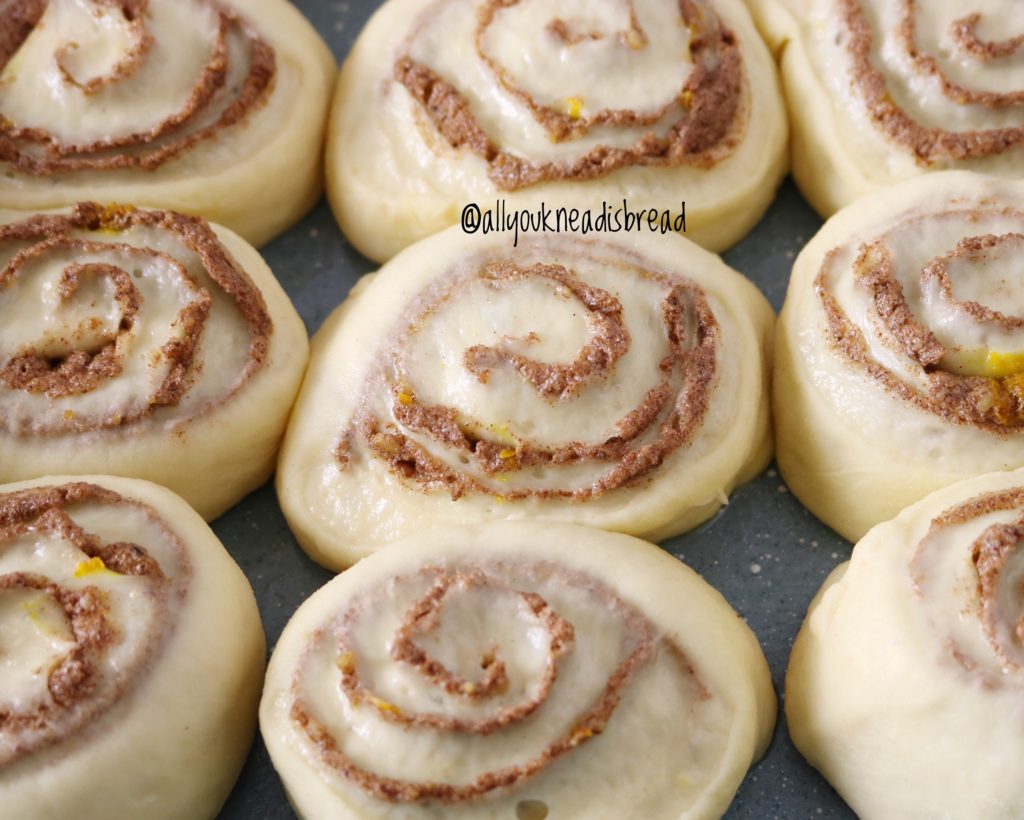
Before they finish proofing, turn your oven on at 350F.
When ready, bake for 30 mins or until the rolls are golden brown. You can brush them with egg wash if you prefer.
Prepare the icing and wait until the rolls cool down a little before you drizzle the icing.
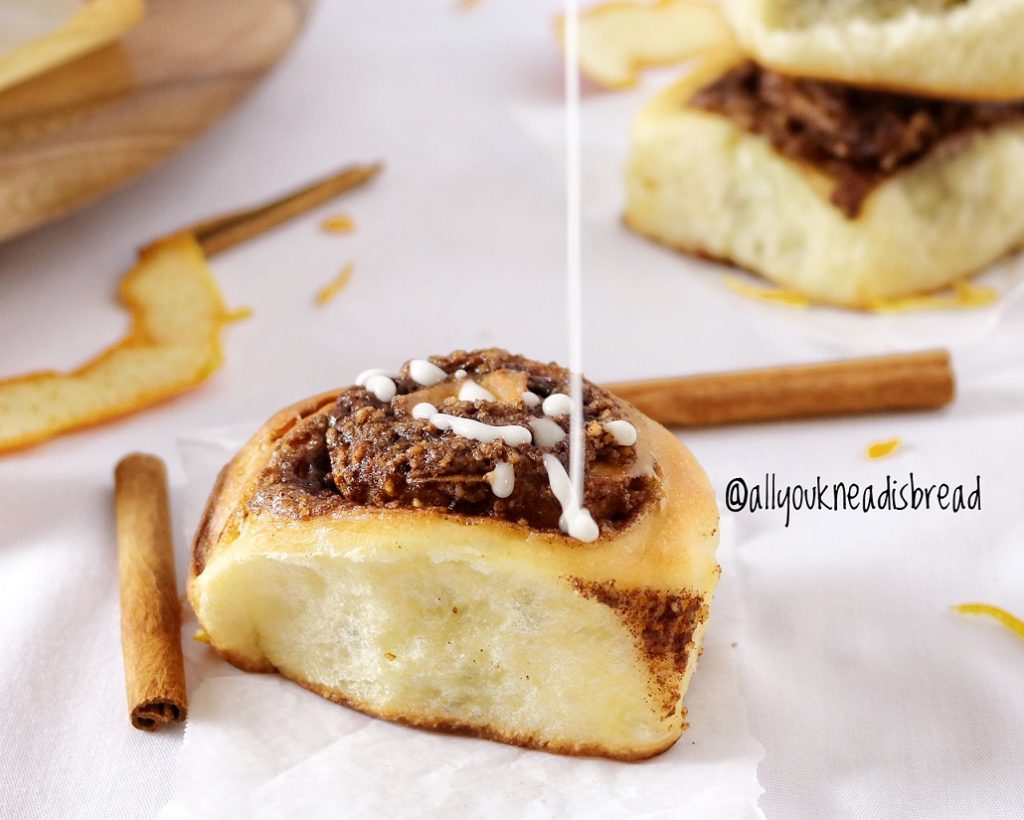
Enjoy!

Sourdough cinnamon rolls with stiff starter
Use lievito madre to make these chewy, soft, and moist cinnamon rolls. It's another level of sourdough goodness!
Ingredients
Dough
- 300 g bread flour
- 100 g lievito madre discards
- 135 g milk
- 50 g butter softened
- 4 g salt
- 2 eggs
- 1 tsp vanilla extract
- 1 tbsp orange syrup or honey optional
- 1/2 tbsp orange blossom water
- 50 g sugar
Filling
- 80 g ground walnuts
- 4 tbsp sugar
- 3 tbsp melted butter
- 2 tsp orange zest
- 1 tbsp ground cinnamon
Icing
- 1/2 cup powdered sugar
- 1-2 tbsp orange juice
Instructions
Dough
-
In the bowl of your stand mixer add the milk, eggs, salt, sugar, vanilla extract, orange blossom water, and orange syrup and combine very well
-
Sift 300 g of bread flour and add them to the wet ingredients
-
Take 100g of the discards from refreshing your lievito madre and cut small pieces and add them to the bowl of the stand mixer
-
Knead at low speed for a few minutes until the dough gets a bit elastic and add the softened butter
-
Knead until you have a perfect gluten development
-
Shape the dough into a ball and place it in a lightly oiled container. Cover it and let it ferment at room temperature until it doubles in size (about 8h in my kitchen)
-
Place the dough in the fridge and let it ferment at a cold temperature for up to 8 more hours
-
Take the dough out of the fridge, deflate it gently and with a rolling pin shape a 35x45cm rectangle
-
Spread the filling and start rolling the log starting on the wider side
-
Cut 9-12 pieces and place them in your 9x9in square pan (use parchment paper if it's not non-stick)
-
Let the rolls proof until they touch each other (about 2h)
-
Bake the rolls in a preheated oven at 350F
-
Drizzle the icing after they cooled down to room temperature
Filling
-
Combine the ground walnuts, sugar, cinnamon, and orange zest
-
Add the melted butter and mix well
Icing
-
Sift the powder sugar
-
Start adding the orange juice until you get the desired consistency
Homemade Christmas Panettone
Christmas is here! Finally! I’ve been really looking forward to the holidays. I can’t wait to turn the laptop off and completely disconnect from anything lab related!
My husband and I decided to go to NYC to spend the holidays instead of going to our home countries. And to be honest, I think it was the best decision. 2018 has been an eventful year, good and bad stuff happened, tears of joy and tears of sorrow. We need a break, a real one. Like a big apple break! Which means I’m not cooking anything for Christmas!
However, I know many people will, and you’ll be looking to impress your guests.
So *guest* what?? (Did you see what I did there? Lol)

It’s panettone time!!!!
Okay, let me say this. It’s NOT the original recipe and I didn’t use any type of
I’ve been working on this recipe for quite a long time. This dough was difficult to handle. But there was something I was NOT going to give up on. And that’s the eggs and sugar content. Which is exactly what makes this dough so difficult to handle. But panettone has to have a strong aroma of eggs, and the yellow color, and it has to be sweet and rich and full of flavor! And it has to last fresh for a long time! Because, let’s be honest. We don’t want to go through all this work for just a couple of days of fresh panettone.
NOPE!
Now.. you do need a strong flour for this: A protein content of at the very least 14-15%.
I could’ve bough the flour online. But I wanted to try something that could be a solution for when you need high gluten flour and you forgot to order it online or you want to save some money in the long run.
I made my own high gluten flour. How? By adding more gluten!
I have wheat gluten at home because I use it to make plant base “meat”. So, what I did was: I first calculated the total amount of gluten in my recipe using a 15% protein flour. Then I calculated the actual protein content of my flour and the gluten I have. And finally, I calculated how much gluten I had to add to my flour.
I know, it sounds weird all these calculations. Don’t worry, I did the calculations for you, so you don’t have to do it. I’ll add another post on how to do it.
Once I adjusted the ingredients to the size of my molds, I tried the recipe with my flour that has 12.7% protein content. It didn’t go very well, I ended up with a cake-like crumb rather than bread.
I tried again adding the gluten. based The quality of the crumb really improved, and the panettones were fresh for 2 weeks at least! (We didn’t have any left after 2 weeks!).
WHAT’S WRONG WITH YOUR FLOUR?
Nothing. Absolutely nothing. However, think about the amount of eggs and sugar and butter panettones have. There are so many things in between the gluten molecules that it’s extremely difficult to develop the gluten network. If you do it by hand it’s going to take you forever. If you use a stand mixer you’ll have to knead the dough for a long long time, and that means that the stand mixer will transfer heat to the dough and make it too soft, and you’ll also take the risk of over kneading the dough. Because stand mixers don’t knead homogeneously. So, chances are that some parts of the dough won’t have good gluten development while other parts will be over kneaded. Long story short, the whole structure will be destroyed.
That’s why we need more protein! If there are more gluten proteins, there are more chances they’ll find each other among all the sugars and fats. Which means, you don’t have to put in such an arduous work to knead the dough, and you reduce the risk of over-kneading it
Don’t smile, it’s still gonna be tough enough lol
BACK TO THE RECIPE!
A panettone is a masterpiece. And you have to do it step by step. No rush. So pick a day that you’ll be home and you’ll have time. You can also make this bread a couple of days ahead of time. Just keep it in a plastic bag so it won’t dry out.
My recipe has two pre-ferments and the final dough. In a warm kitchen you can get it done the same day. Or you can even retard the bulk fermentation overnight in the fridge.
NOTE 1: If you don’t have the high protein flour and you decided to add gluten, make sure you mix it very well with the flour first, otherwise the moment it gets in contact with a liquid it’ll start forming the network and you won’t be able to properly mix the ingredients.
SOAKING THE FRUITS
For this recipe I used golden and dark raisins, candied orange and dried apricots.
I make the candied orange at home and I made this batch barely 1 month ago, they’re still soft, so I did not soak the orange, but I did soak the rest.
In a
I like to start soaking the fruits 1 day in advance, but if you don’t have time or forgot about it, just start soaking the fruits when you start the process. They’ll have enough time to get soft. Plus, the moisture of the dough will also help during the fermentation.
PREFERMENT 1
Once you have your flour ready, add the yeast to the water and let it sit while you whisk the eggs. Then mix the eggs, and the yeast mixture and give it a whisk. It must be very homogenous. Then add the flour and mix very well.
You should have something like a thick pancake batter. Not quite a dough.

When everything is well mixed transfer it to a tall pitcher, mine is 2.5 or 3 qt. And let this preferment rise until it triples or quadruples in size. Look for a place in your house where it’s not too cold. It’ll take some time to start growing. Be patient!
When you see the preferment is all the way to the edges of your pitcher, use your wire whisk or a spatula and try to deflate it a bit. Mine took about 1h 30 mins to 2h approx.

PREFERMENT 2
On another big bowl add the egg yolks and the sugar and mix it very well until you see the eggs getting whiter and fluffy. Then add the honey, the orange syrup (if you have) and the orange, lime and lemon zest and mix thoroughly. Then add the flour (with the gluten mixed already if using this method) and mix again.

Now add the preferment 1 and mix everything very well until you don’t have big lumps and both batters are well integrated. Cover the bowl and let it rise until it triples or quadruples in size. I left mine go up to the bowl edges. This preferment rises quicker

When preferment 2 is ready, time to roll up our sleeves and start working the dough!
FINAL DOUGH
On this

Now… start the workout! I used my stand mixer first. I used the paddle attachment on speed 3 (of 10 total speeds) for about 20 minutes or maybe a bit more. For doughs this sticky, I find the paddle attachment much more efficient to start developing the dough.
NOTE 2: If you’re using a stand mixer, be careful, when the dough starts getting some consistency, it can come up through the hook and get in between the moving parts. Just keep an eye on it!
NOTE 3: The paddle attachment is going to speed things up because the dough is too soft and somehow runny/sticky so the paddle will apply more pressure and will help develop the gluten network better at the beginning.
When I saw the dough was strong enough to pull itself from the bottom of the bowl I stopped and started to add the butter manually. Adding a bit of butter and squeezing it until it was absorbed.
You will notice the change in the consistency!
Keep kneading until the gluten has been developed properly. The dough should be very elastic and you should be able to stretch it without tearing it.

When the dough is good, let it rest 5 mins and then add the fruits. Don’t knead it too much, just enough to make sure the fruits are well distributed.

Put the dough in a lightly oiled bowl and let it ferment!
Look at how thin you can stretch the dough. That’s a sign of a proper gluten development

OPTIONAL STEP: If you think your dough is delicate you can do 3 sets of stretch and folds every 25 mins to improve the structure without destroying it.
At this point, you can place the dough in the fridge for
Let the dough rise until it doubles in size. Then deflate the dough and separate it in two equal parts.
Pre-shape each part into a ball to create some tension and put them in the panettone molds. My molds are the largest ones (6″ x 4½”). The dough should occupy 3/4 of the total volume of the mold.

Preheat your oven at 350F and, in the meanwhile, let the panettones rise until the dough reaches the rim of the mold.

Make a cut on the top of each panettone and open it up a little bit
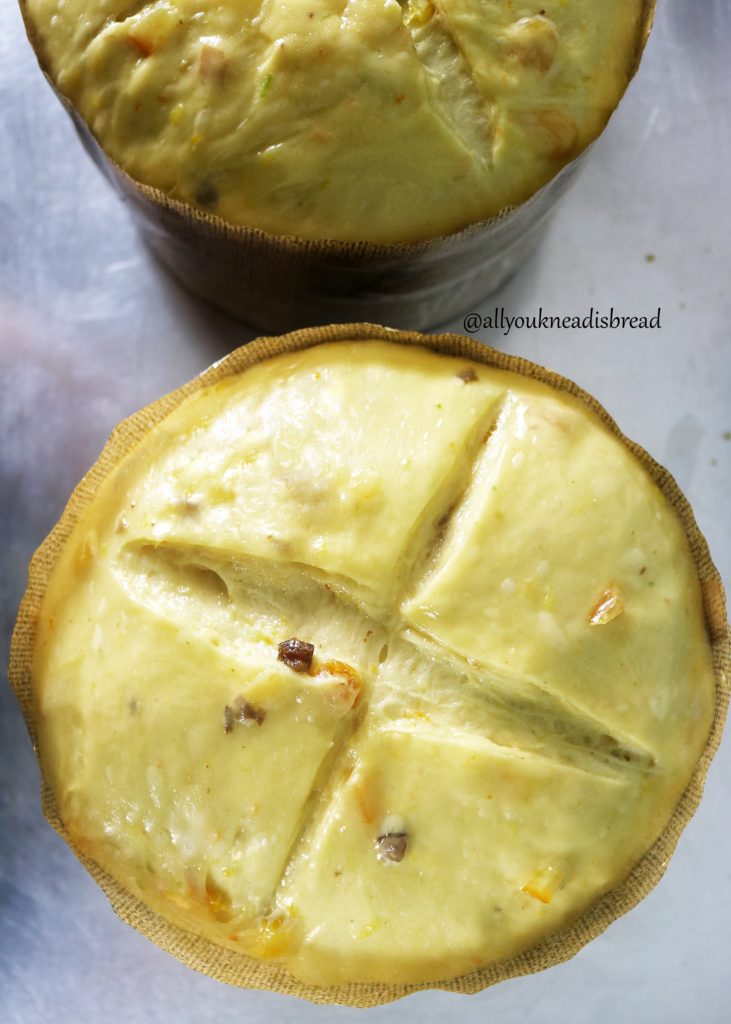
Now add a little bit of butter inside of the cut
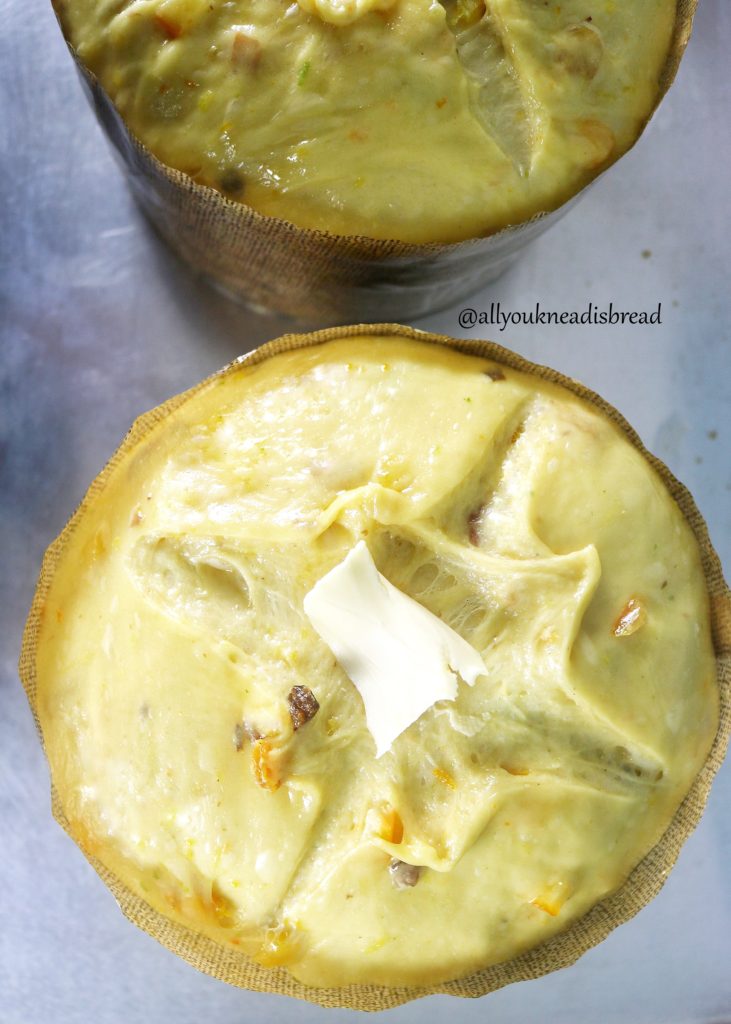
Put the panettones in the oven and turn the oven down to 325F. This way the browning reactions won’t occur too fast.
Bake until they’re ready and immediately after baking insert a skewer in the bottom part of the panettones and hang them upside down until they cool down completely
This step is important because it’ll make sure the crumb and structure are not compromised. After baking the crumb is still finishing cooking, but it’s also too soft and too heavy, so you must be careful, or the panettones could collapse!
Once they cooled down… enjoy this Christmas delicacy! With all the work, I’m sure you’ll enjoy them even more!
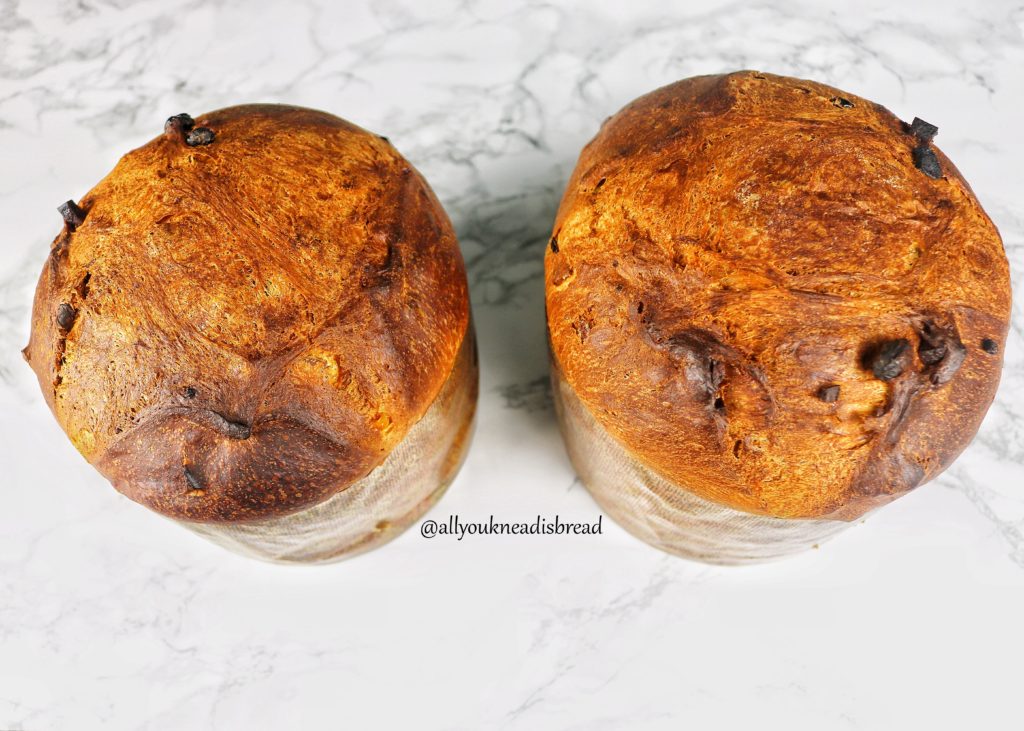
Look at this crumb! Fantastic! So cohesive and soft and yellow and it smells so good!
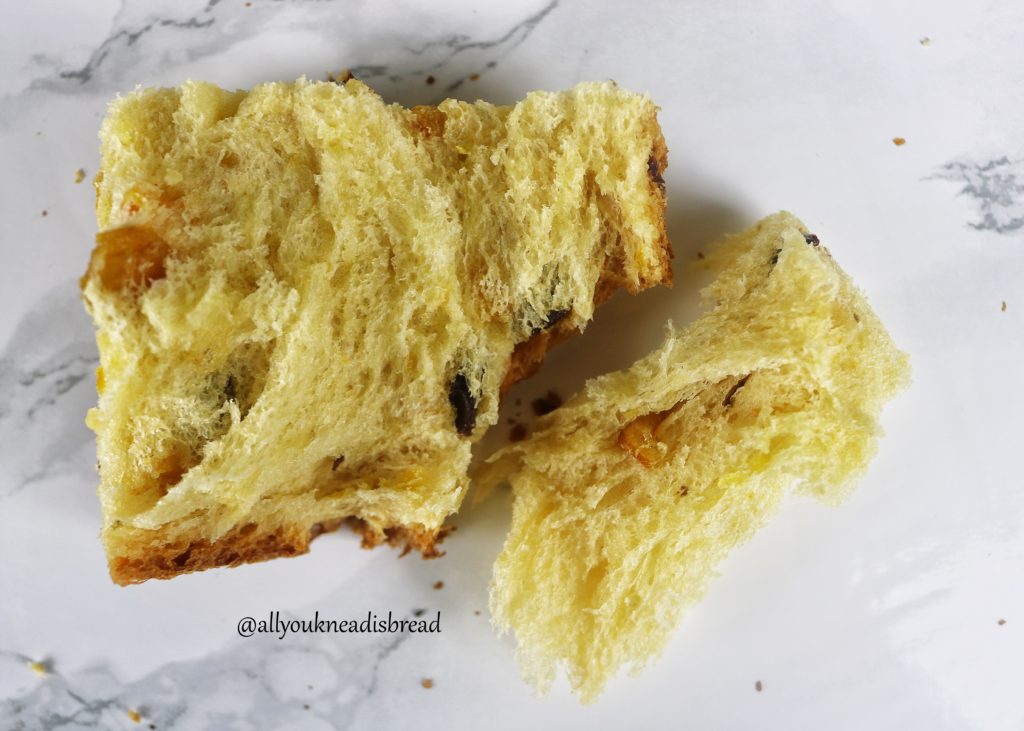
Let me know if you make these panettones or if you have any suggestion/ doubt etc.

Homemade Christmas Panettone
Ingredients
Dried fruits
- 180 g candied orange
- 110 g black raisins
- 110 g golden raisins
- 100 g dried apricots
- 40 g brown rum
Preferment 1
- 470 g bread flour
- 21 g vital wheat gluten
- 390 g water
- 3 L eggs
- 7 g active dry yeast
Preferment 2
- 200 g bread flour
- 10 g vital wheat gluten
- 5 L egg yolks
- 2 tbsp honey
- 2 tbsp orange syrup
- 100 g sugar
- 1 orange zest
- 1 lemon zest
- 1 lime zest
Dough
- 260 g bread flour
- 15 g vital wheat gluten
- 180 g sugar
- 10 g salt
- 227 g butter (2 sticks)
- 2 tbsp vanilla extract (or 2 vanilla beans)
Instructions
Dried fruits
-
Mix the raisins and apricot with the rum 24h prior baking. Shaking the container once in a while to make sure the liquid is distributed evenly.
Preferment 1
-
Mix the flour and the vital gluten
-
Dissolve the yeast in the water and let it sit for 10 minutes
-
Whisk the eggs into the yeast solution and mix very well
-
Add the flour mixture and mix until there are no dry particles
-
Let rise until it triples or quadruples its size
Preferment 2
-
Mix the flour and the vital gluten
-
Whisk the egg yolks until they thicken up a bit
-
Add the honey and orange syrup and mix them very well
-
Add the citrus zest
-
Add preferment 1 and mix very well until there are no big lumps
-
Let rise until it triples its size
Dough
-
Deflate the preferment 2 and add the sugar, vanilla extract. Mix everything very well
-
Mix the flour and the vital gluten
-
Add the flour mixture to the preferment 2 and mix thoroughly until you don’t see dry flour particles and let it rest 20 mins
-
Start kneading. About 20 mins on speed 3 with the paddle attachment of your stand mixer and later use the hook or by hand until the dough gets some consistency. I took 20-25 more minutes
-
Add the butter little by little and keep kneading until its elastic
-
Add the fruits and knead just enough to integrate them into the dough.
-
Place the dough in an oiled container and let ferment until it doubles in size (you can do this step overnight in the fridge)
-
Deflate the dough and separate it into 2 equal pieces
-
Preshape the pieces into balls and place them in the molds
-
Preheat your oven at 350 F
-
Cover the panettones with an oiled plastic wrap and let rise until it reaches the top of the mold
-
Make a cut on the panettones and add a little chunk of butter
-
Put the panettones in the oven and lower the temperature to 325F
-
Bake for about 55 minutes or until they’re brown outside and completely cooked inside.
-
Right after baking insert a skewer through each panettone and turn upside down. Let them cool down completely
Happy Holidays!

